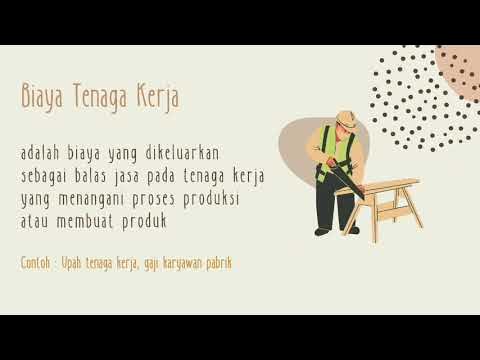Biaya Produksi - Materi PKK Kelas XI || Production Cost
Summary
TLDRThis video lesson explores the essential concept of production costs in business, focusing on key components like direct materials, direct labor, and factory overhead. It emphasizes the importance of calculating production costs to maximize profits and make informed decisions about raw material purchases, production, and pricing. The lesson also covers various cost types, including fixed, variable, total, average, and marginal costs, explaining their roles in production planning. By understanding these elements, businesses can effectively manage and control their production expenses. Future lessons will dive deeper into cost calculations and price setting strategies.
Takeaways
- 😀 Production costs are the expenses incurred in the production process to create goods or services.
- 😀 The main purpose of calculating production costs is to maximize profits by comparing income with expenses.
- 😀 Setting accurate production costs is crucial for businesses to ensure profitability and efficient resource management.
- 😀 Control over production costs is important for management to monitor and adjust spending effectively.
- 😀 Accurate calculation of production costs aids in making short-term business decisions, such as purchasing materials and setting prices.
- 😀 Harga Pokok Produksi (HPP) represents the cost of producing a product and helps determine the price of goods.
- 😀 Direct material costs include raw materials that are physically part of the product, such as flour or chicken in food production.
- 😀 Direct labor costs refer to wages for workers directly involved in production, like chefs or tailors.
- 😀 Factory overhead costs cover indirect manufacturing expenses like maintenance, utilities, and insurance.
- 😀 Fixed costs remain constant regardless of production levels, such as rent or salaried employees.
- 😀 Variable costs fluctuate based on production levels, such as the cost of raw materials or overtime pay.
- 😀 Total costs combine both fixed and variable costs incurred during a specific period.
- 😀 Average costs refer to the cost per unit of production, calculated by dividing total costs by the number of units produced.
- 😀 Marginal costs represent the additional cost incurred to produce one more unit of a product.
Q & A
What is the purpose of calculating production costs in business?
-The purpose of calculating production costs is to compare the revenue generated by a business with the expenses incurred in producing goods or services, thereby helping to maximize profits.
What are the main components of production costs?
-The main components of production costs are direct materials, direct labor, and factory overhead. Direct materials are raw materials used in production, direct labor refers to wages paid to workers directly involved in production, and factory overhead includes indirect costs like utilities and maintenance.
What is the importance of accurately determining production costs for a business?
-Accurately determining production costs is crucial for businesses to make informed decisions, control expenses, and set competitive prices. It ensures that businesses maintain profitability and sustainability.
How does understanding production costs help in decision-making for a business?
-Understanding production costs helps a business make decisions such as purchasing raw materials, setting prices, buying production tools, and managing short-term financial strategies.
What is the cost of goods manufactured (COGM) and why is it important?
-The cost of goods manufactured (COGM) refers to the total cost incurred to produce a product, covering materials, labor, and overhead. It is essential because it forms the basis for calculating the overall production cost and setting product prices.
What is the difference between fixed costs and variable costs?
-Fixed costs remain constant regardless of production levels, such as rent and salaries. Variable costs, on the other hand, change in direct proportion to production output, such as raw materials and labor.
What are factory overhead costs, and how do they differ from direct costs?
-Factory overhead costs are indirect expenses that cannot be traced directly to a specific product, such as utilities, machine maintenance, and administrative costs. They differ from direct costs, which are directly attributable to the production of goods, like raw materials and labor.
What is the total cost in production cost calculation?
-Total cost is the sum of both fixed and variable costs used to produce goods within a specific period. It represents the overall expense a business incurs to manufacture products.
How is average cost calculated, and why is it important?
-Average cost is calculated by dividing the total production cost by the number of units produced. It is important for businesses to understand the cost per unit and help set competitive prices for their products.
What is marginal cost, and how does it impact production decisions?
-Marginal cost is the additional cost incurred to produce one more unit of output. It helps businesses evaluate the cost-effectiveness of increasing production and is crucial in decisions about expanding production capacity.
Outlines

This section is available to paid users only. Please upgrade to access this part.
Upgrade NowMindmap

This section is available to paid users only. Please upgrade to access this part.
Upgrade NowKeywords

This section is available to paid users only. Please upgrade to access this part.
Upgrade NowHighlights

This section is available to paid users only. Please upgrade to access this part.
Upgrade NowTranscripts

This section is available to paid users only. Please upgrade to access this part.
Upgrade NowBrowse More Related Video

(FACIL) Materiales Directos, Mano de Obra Directa, Costos Indirectos de Fábrica

Unsur Unsur Biaya Produksi (Produk Kreatif Kewirausahaan) XII SMK

Menghitung Harga Pokok Produksi - Part 1

Cost Accounting Overview

Biaya Produksi | Biaya Non Produksi | Menganalisis Biaya Prototype Produk Barang/Jasa

Akuntansi Biaya Bab 5 Job Order Costing
5.0 / 5 (0 votes)